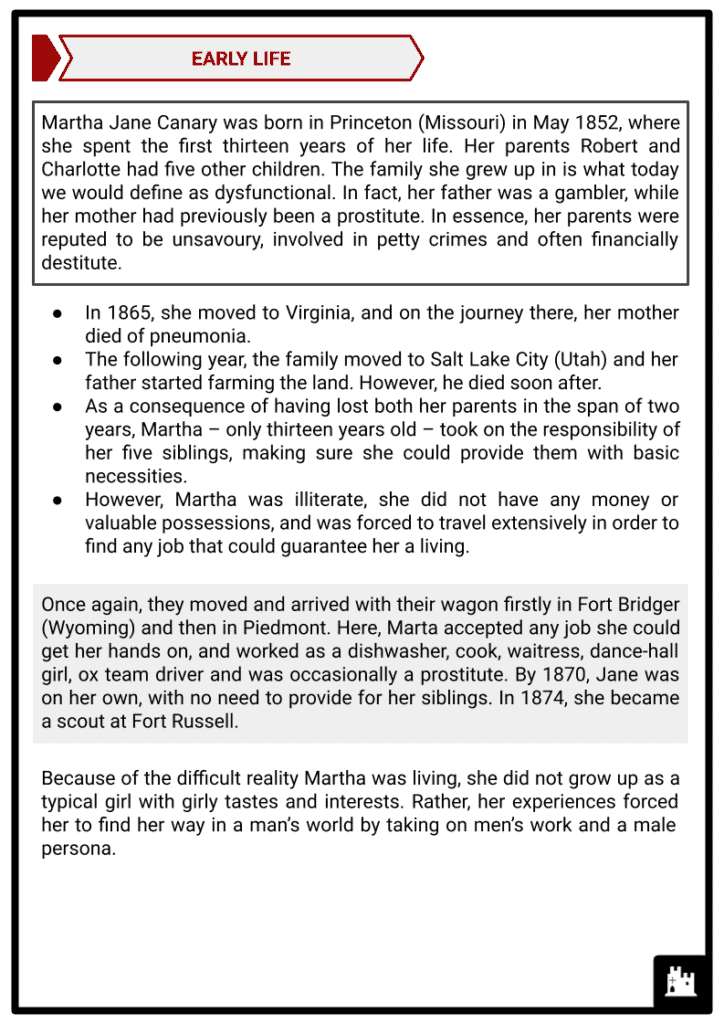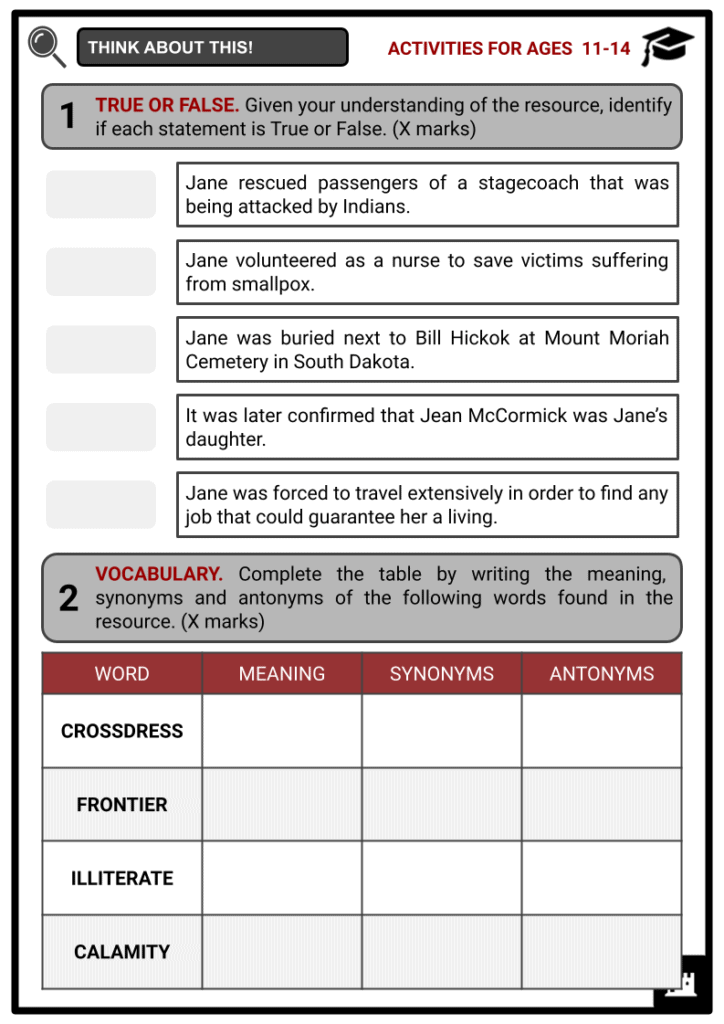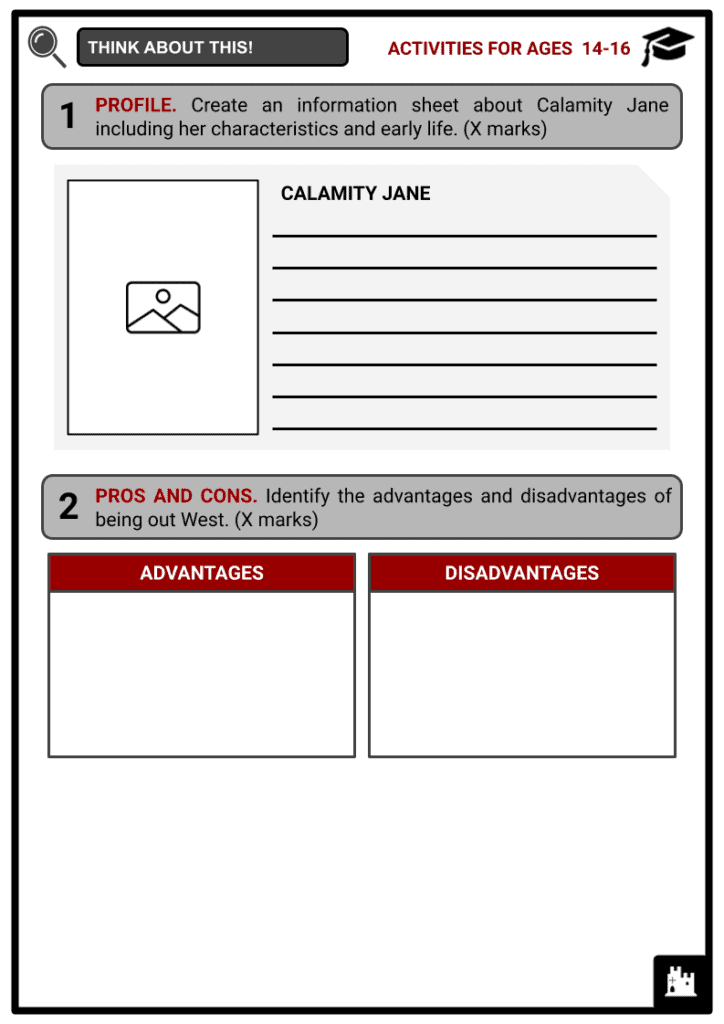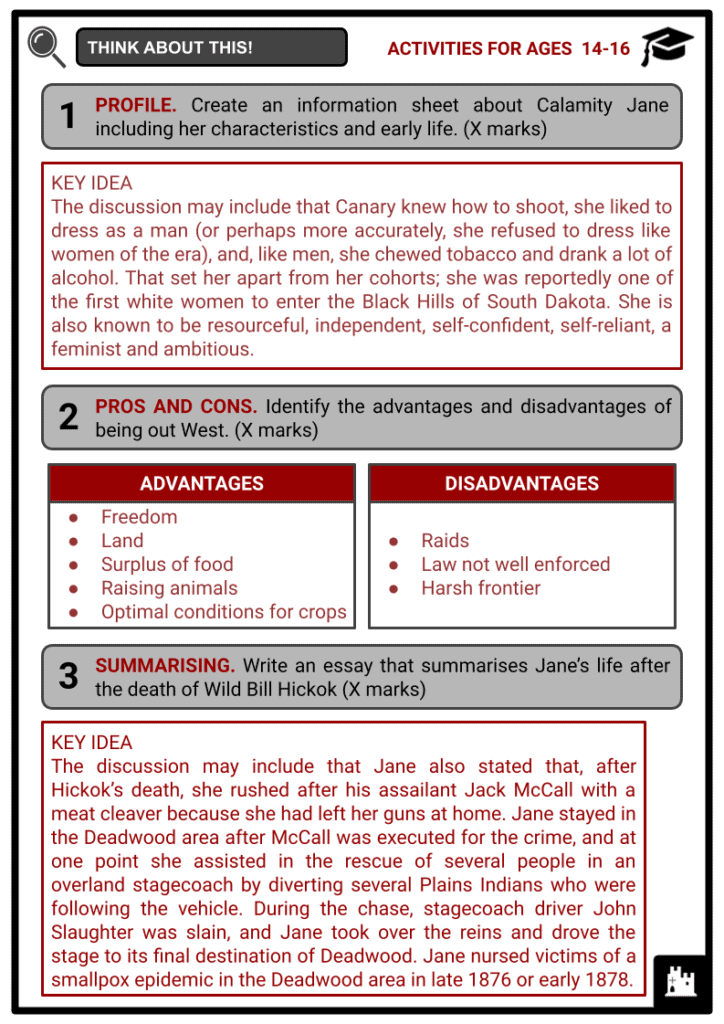Download Calamity Jane Worksheets
Do you want to save dozens of hours in time? Get your evenings and weekends back? Be able to teach Calamity Jane to your students?
Our worksheet bundle includes a fact file and printable worksheets and student activities. Perfect for both the classroom and homeschooling!
Table of Contents
Add a header to begin generating the table of contents
Summary
- Early Life of Martha Jane Canary
- Personal Life of Calamity Jane
- Personality and Traits of Calamity Jane
- The Death of Calamity Jane
Key Facts And Information
Let’s know more about Calamity Jane!
- Martha Jane Canary, commonly known as Calamity Jane, was a well-known woman of the Wild West renowned for her sharp-shooting, whiskey-swilling and cross-dressing ways – but also for her kindness towards others. She is said to have exhibited compassion to others, especially to the sick and needy. This facet of her character contrasted with her daredevil ways and helped make her a notable frontier figure.
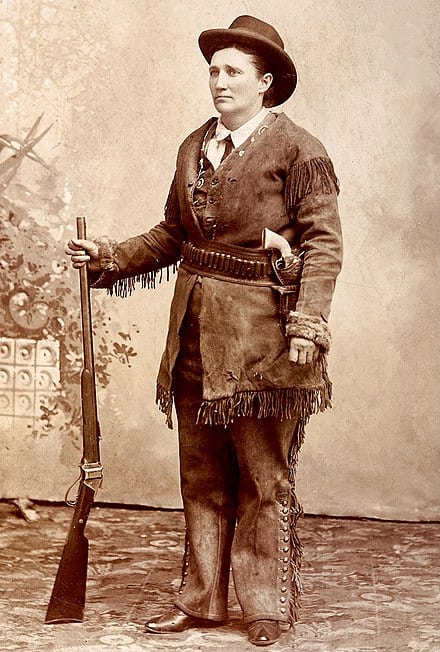
Early Life
- Martha Jane Canary was born in Princeton (Missouri) in May 1852, where she spent the first thirteen years of her life. Her parents Robert and Charlotte had five other children. The family she grew up in is what today we would define as dysfunctional. In fact, her father was a gambler, while her mother had previously been a prostitute. In essence, her parents were reputed to be unsavoury, involved in petty crimes and often financially destitute.
- In 1865, she moved to Virginia, and on the journey there, her mother died of pneumonia.
- The following year, the family moved to Salt Lake City (Utah) and her father started farming the land. However, he died soon after.
- As a consequence of having lost both her parents in the span of two years, Martha – only thirteen years old – took on the responsibility of her five siblings, making sure she could provide them with basic necessities.
- However, Martha was illiterate, she did not have any money or valuable possessions, and was forced to travel extensively in order to find any job that could guarantee her a living.
- Once again, they moved and arrived with their wagon firstly in Fort Bridger (Wyoming) and then in Piedmont. Here, Marta accepted any job she could get her hands on, and worked as a dishwasher, cook, waitress, dance-hall girl, ox team driver and was occasionally a prostitute. By 1870, Jane was on her own, with no need to provide for her siblings. In 1874, she became a scout at Fort Russell.
- Because of the difficult reality Martha was living, she did not grow up as a typical girl with girly tastes and interests. Rather, her experiences forced her to find her way in a man’s world by taking on men’s work and a male persona.
- Martha took part in several military campaigns during the Indian Wars, and it was during this period that she was assigned the nickname ‘Calamity Jane’. In fact, on one occasion – whilst trying to end an uprising of Indians – her detachment was attacked and the captain was shot. Martha was able to save him by catching him as he fell from his horse: she took him back to the fort, and there, the captain called her ‘Calamity Jane…heroine of the Plains’.
Personal Life
- Some sources claim that Calamity had passionate affairs with some of the most famous outlaws of the far west. In fact, many Western novel authors recounted wild stories of her in their books, claiming that she also had a child and married. Nobody knows whether these tales are true or not, but one of the men she did pursue was Wild Bill Hickok (who she met in Cheyenne). Martha fell in love with him, even though her love was unrequited: he was indifferent to her and had no interest in pursuing a relationship with her.
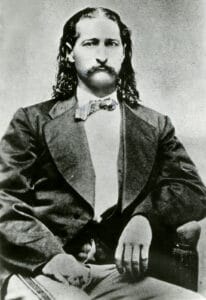
- Hickok was shot in the head during a poker game in Deadwood.
- His murderer was Jack McCall, who had lost a great sum of money in a poker game against Hickok the previous day and had apparently felt insulted when Wild Bill offered him money for breakfast in consolation.
- Although McCall was not charged with murder, Calamity’s priority became that of vindicating the death of the man she loved.
- Therefore, she led a lynch mob against the killer who was fleeing Deadwood.
- Other sources claim that Wild Bill Hickok was never Martha’s lover and that he married another woman before he was shot six weeks later.
- It is said that in 1885 she married a man called either Edward or Clinton Burke, and that from their union a daughter was born in 1887. However, although there are numerous accounts of her being seen with a young girl, there are no marriage or birth certificates to prove it.
- Some historians claim that (I) she married three times and that one of her husbands was imprisoned for physically abusing her; (II) she had a son that she used to call “muzzie’s yittle snoozed darling” and that however died as a child; and subsequently (III) gave birth to Jessie who was bullied in school because of her mother’s bad reputation, and who was given up for adoption when she reached the age of ten.
- Following Hickok’s death, Calamity started drinking and became heavily addicted to alcohol.
- In fact, in 1895, although she joined Buffalo Bill’s Wild West Show as a performer in which she presented to the Americans the commercialised version of the rip-roaring West, she worked sporadically because of her drinking habit.
- Moreover, there are stories that testify Calamity Jane’s wildness due to her drunkenness: for instance, she borrowed a horse in Cheyenne in order to undertake a one-mile ride, but returned the horse after ninety miles.
Personality and Traits
- Some historians believe that Martha Canary’s life is heavily exaggerated in order to fulfil the romantic vision of frontier life. This also happened with the development of Hollywood films depicting scenes from the far west: an example is the film Calamity Jane, interpreted by the feminine and gracious Doris Day in 1953.
- Moreover, in 1941 a woman named Jean McCormick wrote a memoir in which she claimed to be Martha’s daughter, and crystallised the myth of Calamity Jane: it was only decades later that it was discovered she was lying and therefore a fraud.
- Unfortunately, there are not many documents or records that testify to Martha’s life. Even her biography (1886) was propaganda and as Professor McLaird states, “after romantic adventures are removed, her story is mostly an account of uneventful daily life interrupted by drinking binges”. In fact, more than anything, Calamity Jane inspired dime novel writers and became a dime novel heroine.
- Calamity Jane is best known for her adventurous, fearless and tomboyish character. However, there are also several occasions when Martha demonstrated her caring and nurturing side. Some instances have already been mentioned, such as the task of taking care of her siblings from the age of thirteen; and fighting fearlessly to vindicate the death of the man that she loved.
- In a book written in 1924, “two pioneers” defined Calamity as “nothing more than a common prostitute, drunken, disorderly and wholly devoid of any conception of morality”. However, the writers were not able to deny her intrinsically kind nature and the humanitarian act that she undertook.
- However, there are also other episodes that testify to her kind-hearted nature.
- For instance, in 1878, she volunteered as a nurse to save victims suffering from smallpox: in Deadwood all the other women would refuse to help those that had been struck by the smallpox epidemic since they feared they would contract it as well.
- On the other hand, Martha cared for the patients day and night, over the course of weeks.
- On another occasion, Calamity Jane rescued passengers of a stagecoach that was being attacked by Indians and drove the vehicle to Deadwood.
- To conclude, Calamity Jane was an unconventional woman for her time, and because of this, opinions about her vary to a great degree. As Mifflin states, some said she was beautiful, others called her repulsive; according to some she was an ignorant woman of mostly unwomanly habits, whereas another claimed she was “generous, forgiving, kind-hearted, sociable, and yet when aroused, she had all the daring and courage of the lion or the devil himself”.
Death
- In the spring of 1903, Jane returned to the Black Hills, where brothel owner Madame Dora DuFran was still in charge. Jane supported herself for the following few months by cooking and doing the laundry for Dora's Belle Fourche girls. Jane took the ore train to Terry, South Dakota, a small mining town near Deadwood, in late July.
- She had been drinking heavily on board the train and had been ill, according to sources. S.G. Tillett, the railway conductor, pulled her off the train, a bartender found her a room at the Calloway Hotel, and a doctor was sent. Jane’s condition swiftly deteriorated, and she died at the hotel on 1 August 1903, from bowel irritation and pneumonia.
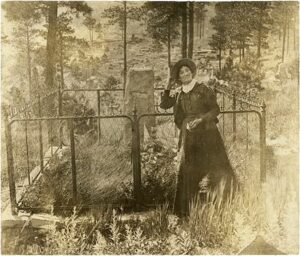
- Calamity Jane was buried next to Bill Hickok at Mount Moriah Cemetery in South Dakota. Hickok had “absolutely no use” for Jane while he was alive, according to four of the men who planned her funeral, so they decided to play a posthumous joke on him by burying her next to him. According to another source, the Society of Black Hills Pioneers took control of her funeral and burial in Mount Moriah Cemetery near Wild Bill, in compliance with Jane’s dying request


